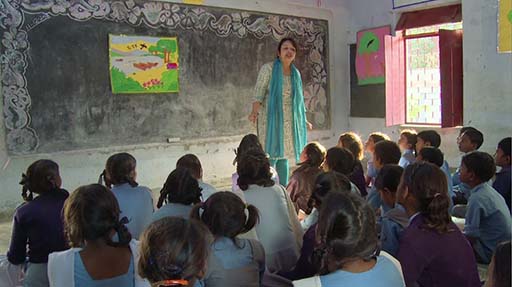2 Establishing classroom routines to use more English
Activity 2: Increase your use of English
Think about the activities that you routinely do in the class and what you say to students before, during and after these activities. Rework what you usually say in Hindi or the local language to English.
Make a copy of Table 1 and fill in what you would say on the right-hand side. We have provided one example for you.
| Getting ready for a game | ‘Are you ready to start?’ |
| Beginning a lesson | |
| Instructions for using a book | |
| Maintaining discipline | |
| Ending a lesson | |
| Organising students to move |
Practise saying these words in English, aloud, slowly and then a bit faster. Work out appropriate gestures or actions for each instruction or comment. Practise with a friend, relative or colleague.
When you feel confident, try out your new English sentences in the classroom. Use gestures, and encourage students to respond in English or in Hindi or in the local language.
Make it a habit to greet students in English, and to give instructions in English for things that you do every day in your classroom.
Teach students to say ‘thank you’, ‘please’ and other polite words for requests by using these words yourself when you speak to them. Also, teach them to say ‘good morning’, ‘sorry’ and ‘excuse me’ to you and to each other; and to use the appropriate expressions for permission to enter, go out or speak – for example, ‘May I …?’ and ‘Can I …?’ Use English to talk about keeping the classroom tidy, or to count the number of students who are present. When you do these things regularly, your own confidence in English will also improve.
When you evaluate students listening and speaking in English, you may observe that they understand the general meaning without understanding individual words. For example, when you say ‘See you tomorrow’, every day when school time is over, students will pick up this phrase. They may understand that it is a form of saying ‘Goodbye’, because of when you say it, but they will not know the meaning of each word in isolation.
You can note, over time, students who remember words and sentences they have heard repeated or routinely, and students who start to use their learning in new situations. Students who recall ‘See you tomorrow’ will learn the word ‘tomorrow’ and will start to use it in new ways – for instance, ‘Tomorrow I go to the city.’ Or they might say ‘See you’ as a way of saying ‘Goodbye’.
You can assess these informal, unplanned opportunities for spontaneous language practice. Support students’ speaking by encouraging all the efforts that they make to speak English, no matter how small. Try to listen carefully when they speak, and do not interrupt to correct small errors. For evaluation, keep a large notebook with a page or two for each student. Use this to build evidence for records of achievement. Note down which students speak easily and confidently, and which students are still too shy to speak. Give the shy ones more opportunities and encouragement to say something in English, and praise them for doing so.
If you have a large class, you can prepare a simple table of checklists to evaluate the students’ progress.
| Students’ names | Uses words occasionally | Uses sentences occasionally | Uses words frequently | Uses sentences frequently | Feels too shy to speak |
|---|---|---|---|---|---|
|
|||||
|
Activity 3: Record yourself in the classroom
Take your mobile phone into your classroom and record the first ten minutes of a lesson where you normally use English. (It does not have to be a language lesson.)
Listen back to what you recorded two or three times and answer these questions:
- How much English did you speak? What words or phrases did you use?
- Were you surprised at how much English you used? Was it more or less than you predicted?
- Did the students use English in response to you? How did you know that they understood what you said?
- Did you switch to Hindi or a local language during the ten minutes? When did you do this, and why?
- Listen to the sections where you used Hindi or the local language. Can you now think of words and sentences in English that would say the same things? Write these down – use a dictionary if you are not sure about the words, or ask another teacher or friend. Your challenge is to start using these English words in your classroom routines.
1 Using teacher talk

